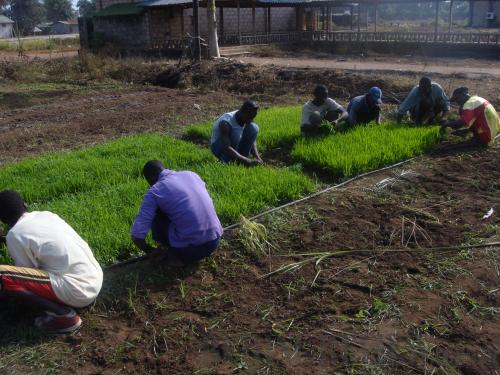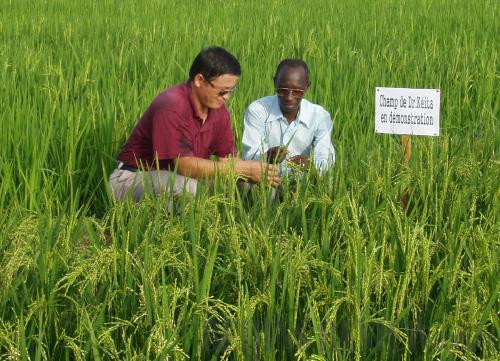|
 |
|
(COURTESY OF SHI JINGUI) |
 |
|
GREEN WAVES: A Chinese agricutural technician shares his rice growing expertise with a colleague at Koba Farm in Guinea (COURTESY OF SHI JINGUI) |
Government support
China's agricultural success is the result of meticulous planning. Since 2004, the Chinese Government has made agricultural development its top priority for seven successive years. Along with this, a minimum purchasing price of grain was set to avoid major fluctuations in the food market and protect farmers' interests. In 2006, China also exempted the agricultural tax nationwide, meaning farmers do not need to pay the government tax on their land and can receive subsidies when buying agricultural machinery.
"Because China is a populous country, the government needs to give top priority to grain production so as to feed its people independently," Shi Jingui, Vice Division Director of Overseas Development Department of China State Farms Agribusiness (Group) Corp., told ChinAfrica. "[Putting food in] the bowl of Chinese people should not be determined by other people," he added, referring to the importance of grain self-sufficiency.
Shi said that the measures taken by the government, especially the exemption of agricultural tax and setting a minimum grain price, greatly stimulated farmers' enthusiasm.
In 2009, China's grain production reached 531 million tons, the sixth year of successive growth (see graph).
Smart option
Despite the prominent production growth, there are some problems in China's agricultural development, which are similar to some African countries, said Shi. One of the problems is the lack of labor and agricultural technology. With the development of urbanization, many young people choose to work in cities, leaving the farmlands to women and older folk. "This surely affects grain production," said Shi.
Quzhou County, Hebei Province seems to have found a good way to solve the problem of the youth migrating. Owing to the lack of laborers and skilled people, the grain production was lower in Quzhou than in the surrounding counties in previous years.
In 2008, organized by local government, 59 families in the county's Baizhai Town allowed China Agricultural University to use their 160 mu (a Chinese measurement of land area, about 0.067 hectare) of farmland as an agricultural technology demonstration base.
"This is a win-win cooperation between our university and farmers," said Professor Li Xiaolin, from the China Agricultural University, who has been working in Quzhou for almost three years. On the one hand, the base can provide a platform for students to practice what they learn in class; on the other hand, this can also solve the problem of local farmers lacking sufficient laborers and technologies.
Such cooperation turned out to be a blessing. In 2009, the average corn production in the base reached 638 kg per mu, a year-on-year increase of 16.7 percent and 92 kg more than the yield of farmland outside the demonstration base; the wheat production hit 441 kg per mu, up 10.3 percent year on year and 41 kg more than other comparable farms.
Currently, the agricultural technology demonstration base has been expanded to 8,600 mu (574 hectares), covering 14 villages in three towns.
Practical help
Shi said that China possesses quite high agricultural development technologies and has been assisting Africa in this regard for many years.
At the Beijing Summit of FOCAC in 2006, Chinese President Hu Jintao declared that 10 agricultural technology demonstration centers would be established in African countries, 100 high-level agricultural technicians would be dispatched there, and efforts would be made to train Africans. At the fourth FOCAC Ministerial Meeting held in Sharm el-Sheikh in 2009, Chinese Premier Wen Jiabao announced to increase the number of agricultural technology demonstration centers to 20.
So far, 14 such centers have been established and put into service and a total of 104 veteran agricultural technicians have been sent to African countries such as Sierra Lione, Namibia and Morocco.
"The 14 agricultural technology demonstration centers are running smoothly, playing important roles in disseminating China's advanced agricultural technologies, improving local crop varieties and promoting China's farming experience in Africa," said Li Jinjun.
Shi is one of the high-level agricultural technicians sent by the Chinese Government to work in Africa. From December 2008 to December 2009, he led a group of three to Guinea and promoted the technology of rice growing in the West African country.
Shi's employer, the China State Farms Agribusiness (Group) Corp. has a farm in Guinea called Koba Farm, covering more than 2,400 hectares, and Shi decided to use a small part of the farm to demonstrate Chinese agricultural technologies and crop varieties, including the famous hybrid rice. He reformed the irrigation and drainage systems and tried Chinese crops varieties and technology.
"Our experiment showed that the variety [of hybrid rice] can be well adapted to the soil, sunlight conditions, temperature and rainfall conditions in Guinea," said Shi.
Results showed that Shi's experiment was successful. The average production on the experimental land yielded almost 10 tons of hybrid rice per hectare in 2009; while the average production of rice in Guinea is only 1.5 tons per hectare.
"I think, for Guinea, the most important thing is to choose good crop varieties and promote good agricultural technologies to local farmers," said Shi.
China's grain production (ml. tons)
2003: 431
2004: 469
2005: 484
2006: 498
2007: 502
2008: 529
2009: 531
Source: National Bureau of Statistics
Grain production of Africa as a whole (ml. tons)
2007: 104.4
2008: 156.7
2009: 163.8
Source: FAO
|